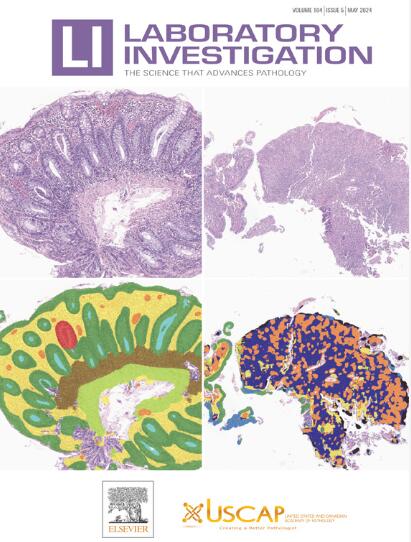Exploring Molecular Characteristics and Therapeutic Strategies for Primary Sinonasal Mucosal Melanoma With Distant Metastasis
IF 4.2
2区 医学
Q1 MEDICINE, RESEARCH & EXPERIMENTAL
引用次数: 0
Abstract
Sinonasal mucosal melanoma (SNMM) is a rare aggressive malignancy of the sinonasal tract. Due to its advanced clinical presentation and frequent late-stage diagnosis, the 5-year survival rate is <30%, with an even worse prognosis in patients with distant metastasis (SNMM-M). Therefore, characterizing the molecular landscape of SNMM may provide novel therapeutic targets for SNMM-M. This study aimed to decipher the histopathological and molecular landscape of SNMM-M and yields novel insights into potential therapeutic approaches using targeted DNA and RNA next-generation sequencing, immunohistochemistry, and fluorescence in situ hybridization. SNMM-M cases were characterized by epithelioid-predominant morphology, frequent tumor necrosis, minimal pleomorphism, and sparse tumor-infiltrating lymphocytes (TILs). A significant association between the absence of brisk TILs and metastasis in SNMM was noted. Moreover, the presence of lymphovascular invasion and absence of brisk TILs were both significantly associated with poorer overall survival in patients with SNMM. Both DNA and RNA sequencing identified no gene fusions, whereas DNA sequencing revealed 304 genomic alterations across 186 genes, including 9 multihit genes. Notably, missense mutations in structure-specific endonuclease subunit (SLX4), a key homologous recombination repair scaffold protein, were exclusively detected in SNMM-M, and patients with SLX4 mutations exhibited significantly worse survival (median, 9.9 vs 41.2 months without SLX4 mutations; P < .0001). A comparative analysis of genomic alterations and copy number variations of clinically actionable genes between SNMM-M and SNMM without distant metastasis (SNMM-nM) revealed that CDK4 gains/amplifications were commonly seen in SNMM-M cases, whereas receptor tyrosine kinase and homologous recombination repair gene alterations were highly enriched in SNMM-nM cases. Additionally, PD-L1 was more commonly expressed in SNMM-nM. These exploratory findings suggest that SLX4 mutation may serve as a potential prognostic biomarker and that CDK4 inhibitors could represent promising therapeutic options for SNMM-M. However, given the limited sample size, further validation in larger studies is essential to confirm these findings.
原发性鼻窦黏膜黑色素瘤伴远处转移的分子特征及治疗策略探讨。
摘要鼻黏膜黑色素瘤是一种罕见的侵袭性鼻黏膜恶性肿瘤。由于临床表现较晚,多为晚期诊断,5年生存率不足30%,伴有远处转移(SNMM-M)的患者预后更差。因此,表征SNMM的分子景观可能为SNMM- m提供新的治疗靶点。本研究旨在破译SNMM-M的组织病理学和分子景观,并利用靶向DNA和RNA下一代测序,免疫组织化学(IHC)和荧光原位杂交(FISH)为潜在的治疗方法提供新的见解。SNMM-M以上皮样细胞为主,肿瘤坏死多发,多形性极少,肿瘤浸润淋巴细胞稀疏。注意到SNMM中没有活跃的TILs与转移之间存在显著关联。此外,在SNMM患者中,LVI的存在和轻快TILs的缺失都与较差的总生存期显著相关。DNA和RNA测序均未发现基因融合,而DNA测序显示186个基因中有304个基因组变化,其中包括9个多命中基因。值得注意的是,结构特异性核酸内切酶亚基(SLX4)是一种关键的同源重组修复(HRR)支架蛋白,在SNMM-M中只检测到错义突变,SLX4突变患者的生存期明显较差(中位数:9.9个月比无SLX4突变的41.2个月,P < 0.0001)。对比分析SNMM-M和SNMM-nM之间临床可操作基因的基因组改变和拷贝数变化,发现CDK4扩增在SNMM-M病例中普遍存在,而受体酪氨酸激酶和HRR基因的改变在SNMM-nM病例中高度富集。此外,PD-L1在SNMM-nM中更常表达。这些探索性发现表明,SLX4突变可能作为一种潜在的预后生物标志物,CDK4抑制剂可能是SNMM-M的有希望的治疗选择。然而,由于样本量有限,需要在更大规模的研究中进一步验证才能证实这些发现。
本文章由计算机程序翻译,如有差异,请以英文原文为准。
求助全文
约1分钟内获得全文
求助全文
来源期刊

Laboratory Investigation
医学-病理学
CiteScore
8.30
自引率
0.00%
发文量
125
审稿时长
2 months
期刊介绍:
Laboratory Investigation is an international journal owned by the United States and Canadian Academy of Pathology. Laboratory Investigation offers prompt publication of high-quality original research in all biomedical disciplines relating to the understanding of human disease and the application of new methods to the diagnosis of disease. Both human and experimental studies are welcome.
 求助内容:
求助内容: 应助结果提醒方式:
应助结果提醒方式:


